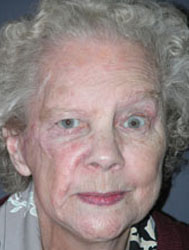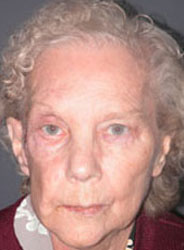New York Center for Facial Plastic Surgery
Schedule a consultation

Information About Facial Paralysis Surgery in New York, NY with Dr. Andrew Jacono

Facial nerve paralysis occurs as a result of damage to the facial nerve. Paralysis may cause an imbalance of the face at rest, as well as distorted, asymmetrical facial expressions like smiling and laughing.
Functionally, facial nerve injuries affect chewing, fluid retention while drinking, nasal breathing, and speech patterns. In children, facial paralysis occurs developmentally or after brain tumor resection. Adults may experience complete or partial paralysis after an episode of Bell’s Palsy, acoustic neuroma, or trauma.
Surgery aims to either completely reverse paralysis or improve functionality in affected areas.
Facial paralysis patients usually have questions about their condition. The most common questions include:
The most common cause is Bell’s Palsy. This is a form of temporary facial paralysis or weakness on one side of the face. Usually, its onset is sudden and worsens over the course of 2 days. It results from a dysfunction in the cranial nerve, which directs the muscles of the face.
Bell’s Palsy impacts the ability to blink and form facial expressions and can occur in anyone of any age.
Other forms of facial paralysis are caused by direct trauma to the face and damage to nerves. Sometimes, however, there is no immediate or discernible cause.

Facial paralysis has a variety of symptoms. Patients may experience loss of facial muscle tone, which in turn causes droopiness of the brow, eyelid, nostrils, cheeks, and lips. Functional loss of dynamic muscle control can result in abnormal oral communication skills.
Weakness of muscles around the eyes also causes incomplete eye closure, excessive corneal exposure, and tearing. Paralysis of the small nasal muscles leads to nostril collapse.
In the upper third of the face, patients may be unable to wrinkle one side of their forehead. The brow may also droop over the eye, blocking vision.
Perhaps the most devastating symptom of nerve paralysis is the loss of the ability to smile. This is especially heartbreaking for younger patients and their families. In order to talk, smile, and pucker the lips, the mouth must be able to close; facial nerve paralysis prevents this.
Facial paralysis can be treated surgically in a number of ways.
If the forehead sags and blocks vision, Dr. Jacono performs either a brow lift or an endoscopic brow lift. These procedures reposition the droopy eyebrow and forehead. Another option is to use Botox, or Botulinum Toxin, which lifts and evens out the brows.
For patients whose cheeks droop, Dr. Jacono performs an endoscopic midface lift to tighten the area. If the jawline droops, on the other hand, he prefers to perform a combination of a facelift and a neck lift. If the mouth is affected by facial nerve paralysis, Dr. Jacono performs a regional muscle transfer. This harvests muscle from the scalp or neck.
The newest, most revolutionary technique, is the temporalis tendon transfer, which transfers a small tendon from the muscle used to chew. This helps the corner of the mouth move. Incisions are small and invisible after recovery.
Sometimes, Dr. Jacono uses cross-facial nerve grafts (nerves harvested from a donor site on the calf). This allows him to splice into selected branches of the facial nerve on the normal side of the face. These grafts serve as a conduit for the growth of “electric wiring” in the face’s paralyzed side.
In cases of a recent injury, the muscles are reawakened by the growth of new nerves. In long-standing cases of facial paralysis, a second-stage procedure transfers fresh muscle from the inner thigh. Outcomes are not always predictable, but in most cases, facial balance is restored.
Dr. Andrew Jacono is a Double Board Certified Facial Plastic Surgeon. His primary concern is protecting the functions of the facial muscles. Without the blink reflex or the ability to close the eye, the cornea can become dried out and injured. This can damage vision. In cases like these, a gold weight can be placed in the upper eyelids through a blepharoplasty (eyelid surgery). This gold weight is dense and helps the upper eyelids close.
Prospective patients should be aware that there are no guarantees with facial paralysis surgery. However, Dr. Jacono routinely conducts successful procedures that restore facial balance and a range of expressions. Dozens of clients have visited from all around the world for reconstructive surgery. They have since experienced an improved quality of life.
New York Center for Facial Plastic Surgery
Schedule a consultation

Patients with Bell’s Palsy typically make a full recovery within 9 months of diagnosis. However, this may take longer. In rare instances, nerve damage and paralysis can be permanent.
Without surgery, those with trauma-induced facial paralysis may have permanent loss of facial function.
This patient had paralysis on her right side. This occurred after the removal of a cancerous tumor. She experienced brow drooping that limited her ability to close her eye. Dr. Jacono performed a browlift and an upper eyelid gold weight implantation. The patient now has a more symmetrical face.


This patient had Bell’s Palsy. It caused facial paralysis on her right side (left side of the picture). Dr. Jacono performed reconstructive surgery with a temporalis tendon transfer. Notice how much more balanced the mouth looks after surgery.



Accessibility: If you are vision-impaired or have some other impairment covered by the Americans with Disabilities Act or a similar law, and you wish to discuss potential accommodations related to using this website, please contact our Accessibility Manager at (212) 570-2500 .